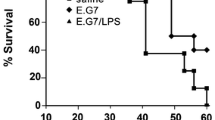Abstract
Lipopolysaccharide (LPS) has been recognized as a potent antitumor agent in animal tumor models; however, its use in human cancer therapy has been limited to only one trial, in which LPS from Salmonella was given intravenously. It was not very successful because of poor tumor response and was also toxic. We originally developed LPS prepared from Pantoea agglomerans (LPSp), and this was a well-purified, small-molecular-mass (5 kDa) agent. We chose intradermal rather than intravenous administration in the hope that the former would release LPS slowly into the bloodstream, and thus be less toxic while preserving antitumor activity. In our animal tumor models, intradermal administration was indeed less toxic and more beneficial for tumor regression than intravenous administration. We made a pilot study with intradermal administration of LPSp on the treatment of ten advanced cancer patients. Five of them had evaluable tumor, which had failed earlier to respond to conventional chemotherapy. Cyclophosphamide was also administered in this trial, in anticipation of its synergistic effect with LPSp. In this study LPSp was injected intradermally into each patient twice a week, starting with an initial dose of 0.4 ng/kg, and raising it to 600 or 1800 ng/kg. A 400-mg/m2 dose of cyclophosphamide was given intravenously every 2 weeks. After completion of the dose escalation, the treatment was continued for at least 4 months, and it was found that 1800 ng/kg LPSp was well tolerated. A significant level of cytokines was observed in the sera for at least 8 h. These results indicate higher tolerable doses and remarkably more continuous induction of the cytokines than were reported in a previous study by others using intravenous administration. Three of the five evaluable tumors showed a significant response to our combined therapy. Intradermally administered, LPS was less toxic and elicited a tumor response in combination with cyclophosphamide; it can thus can be applied to cancer treatment even in humans.
Similar content being viewed by others
Author information
Authors and Affiliations
Additional information
Received: 3 August 1995 / Accepted: 2 April 1996
Rights and permissions
About this article
Cite this article
Goto, S., Sakai, S., Kera, J. et al. Intradermal administration of lipopolysaccharide in treatment of human cancer. Cancer Immunol Immunother 42, 255–261 (1996). https://doi.org/10.1007/s002620050279
Issue Date:
DOI: https://doi.org/10.1007/s002620050279




